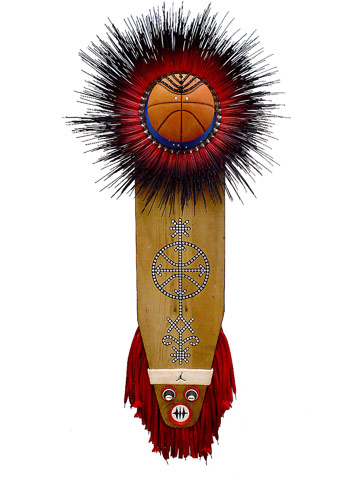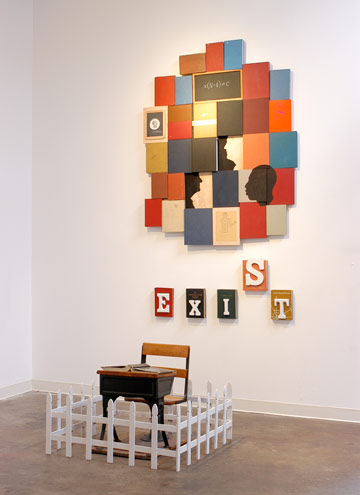
André Leon Gray, "Black Magic (It's Fantastic)," 2005. Acrylic, rhinestones, basketball, synthetic braided hair, street sweeper brush, shoe laces, headband, miniature clay pots, wood, cowrie shells on wood ironing board, 67 x 31 x 9 1/2 inches. Courtesy the artist.
One of the most striking things about the new West Building at the NC Museum of Art is its curatorial strategy. From almost any vantage point in the gallery, the experience is a hybrid one in which contemporary impressions blend with the historical, and expected categories and constraints like geography and milieu loosen their grasp.
From the entry, amidst Jaume Plensa’s Doors of Jerusalem, I, II & III, the presence of the museum’s African collection makes itself known. A recent commission by El Anatsui lurks straight ahead in a gallery flanked by similarly scaled pieces by Sean Scully, Gerhard Richter, and Anselm Kiefer.
One encounters the African gallery by way of a phased entry from the contemporary collection, via Mustafa Maluka and Ledelle Moe — whose Congregation spreads over the anterior wall — or from the main entrance, marked by a splendid Yoruba Egungun Masquerade Costume. Nestled near the center of the hall is a piece called Black Magic (It’s Fantastic), by Raleigh artist André Leon Gray. The appearance of the totem among more historical media plays on a surprising counterpoint — it first seems right at home among the alters, flags, and costumes in the gallery. Then one notices the rhinestone pattern, the basketball, the headband with the Air Jordan logo. The radiating quills encircling the ball are, upon closer inspection, a street sweeper’s brush. The assemblage is mounted on a plank — wait, an ironing board. (The piece made its world debut at the DUMBO General Store and Gallery in Brooklyn in 2005. It will be on view until April 2011 at the NC Museum of Art.)
Gray affectionately calls his mixed media assemblages, sculptures, installations, tar paintings, and drawings eye gumbo — its eclectic appeal belies its complexity in terms of materiality, origination, and potent intent. As he describes it, the work is “thickened with a roux of Black culture, marinated in social commentary and seasoned with consciousness.” Gray’s work surreptitiously coaxes its way into an audience’s psychic safe spaces, only to explode with meaning and provocation once inside. In a recent piece, emblematic iconography and shades of an easy pun become a knockout punch of historically-anchored prophecy once one gets to the work’s title, Temporary Government Housing, and realizes the piece is painted in tar. In Head Full of Doubt, nostalgic hues and the apparent comity of a schoolhouse scene yield to perennial existential questions and the lingering equation: x(N – 3/5) ≠ C. As Amy White writes: “It’s an equation about inequality, the centerpiece of which echoes the ‘three-fifths compromise’ of 1787, which pertained to the taxation and representation of nonwhite people under the Constitution of the new United States. Every time it appears in one of Gray’s works it serves as an elegiac coda. It signals the unspeakable, abbreviating the highest degree of injustice without allowing us to escape it.”

André Leon Gray, "Temporary Government Housing," 2009. Tar on canvas, 63 x 90 inches. Courtesy the artist.
I asked André Leon Gray to respond to the prompt: What does being here have to do with your particular practice? What does your practice have to do with being here?
My interest as an artist born and raised in the South is one akin to an African griot. A griot is a storyteller, a keeper of tradition, who passes on a culture’s history, myths and legends to the next generation. A constant blueprint guiding my work as a social practice is my philosophy of art as a powerful vehicle to explore themes of our hue-man condition — bright and dark memories that have been woven into the fabric of our collective consciousness — and how we perceive and respond to them. Learning from the past moves us into the future.
My work is born in the South, but doesn’t limit itself to a Southern dialogue. Being in North Carolina versus New York City gives me the opportunity to observe the true state of race relations and the “problem of living” in the mythological post-racial America which supposedly began when Barack Hussein Obama was elected as the POTUS in 2008. Being here spawns artwork that speaks of being and (in)visibility, a shared history, and the contemporary livelihood of African Americans.

André Leon Gray, "Head Full of Doubt" (installation side view), 2010. Acrylic on wood, white charcoal on chalkboard, paper collage, petri dish, reclaimed textbooks, old school desk, wooden picket fence. Dimensions variable. Courtesy the artist.



